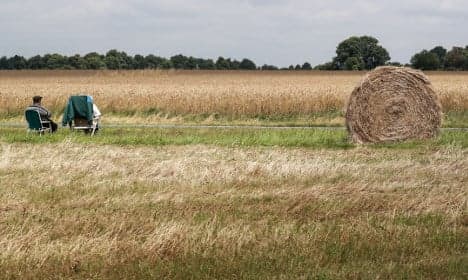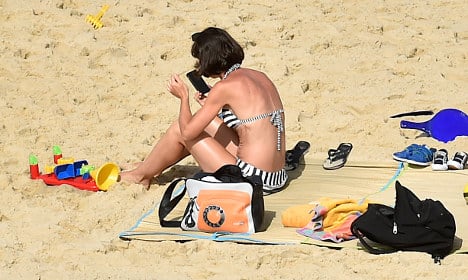Rural France great for peace, not for mobile phone coverage

Getting 4G in rural France is still difficult, a new study confirms, but it also depends on which provider you are with. This interactive map should help you decide.
France has some 36,000 communes but there is no égalité when it comes to mobile phone coverage, a new study and interactive map have revealed.
France’s telecoms communications authority Arcep has published its annual report into the quality of mobile phone services across the country and there were stark differences between the various providers.
Top of the rankings came Orange, ahead of Bouygues Telecom then SFR, which were “neck and neck”. Propping up the table came Free, a newish service known for offering cheaper rates, but also for having issues with its network coverage.
But in reality the quality differs depending on where you are in France.
 (AFP)
(AFP)
An interactive map published on the Europe 1 website (see below) gives readers the chance to check out the quality of coverage by each provider in each one of the 36 000 communes.
The map reveals that while in Paris all four providers have pretty much 100 percent coverage, down in the Dordogne, things are different.
In the town of Eymet, Bouygues or SFR have zero percent coverage (Is that right people in Eymet?) while Free has 63 coverage and Orange 48 percent.
As expected 4G coverage is far patchier in rural areas compared to the main cities with download speeds in parts of the countryside around 6Mbit per second compared to 30 Mbit per second in big urban areas.
In general only between 21 percent and 35 percent of the country is covered. Although that's up on the 15 percent to 20 percent of the country covered by 4G last year.
The annual report on 2G, 3G and 4G services by Arcep looked at several criteria to judge providers whether it was time to download web pages, coverage on motorways or rail routes, call quality and speed of sending text messages.
Their work revealed that overall it was Orange that confirmed itself as leader of the market in both the big cities and the countryside – when it comes to making calls, sending texts and surfing the internet.
But the study revealed that it’s also the most expensive for customers given the average price of contracts.
SFR and Bouygues were found to be fairly equal although SFR performed better in the countryside on the whole as well as on motorways throughout the country.
Bouygues on the other hand has a better coverage in the big towns.
Free, the youngest of the network’s had came bottom of the table, largely due to the fact that it hasn’t set up its own network of antennas yet.
Free has been using Orange’s own network to provide its service but in January Arcep ordered it stop as soon as possible and set up its own.
Using Orange’s network was beneficial to help Free establish itself as a fourth mobile phone provider but it was not sustainable in the long run, Arcep ruled.
Comments
See Also
France has some 36,000 communes but there is no égalité when it comes to mobile phone coverage, a new study and interactive map have revealed.
France’s telecoms communications authority Arcep has published its annual report into the quality of mobile phone services across the country and there were stark differences between the various providers.
Top of the rankings came Orange, ahead of Bouygues Telecom then SFR, which were “neck and neck”. Propping up the table came Free, a newish service known for offering cheaper rates, but also for having issues with its network coverage.
But in reality the quality differs depending on where you are in France.
 (AFP)
(AFP)
An interactive map published on the Europe 1 website (see below) gives readers the chance to check out the quality of coverage by each provider in each one of the 36 000 communes.
The map reveals that while in Paris all four providers have pretty much 100 percent coverage, down in the Dordogne, things are different.
In the town of Eymet, Bouygues or SFR have zero percent coverage (Is that right people in Eymet?) while Free has 63 coverage and Orange 48 percent.
As expected 4G coverage is far patchier in rural areas compared to the main cities with download speeds in parts of the countryside around 6Mbit per second compared to 30 Mbit per second in big urban areas.
In general only between 21 percent and 35 percent of the country is covered. Although that's up on the 15 percent to 20 percent of the country covered by 4G last year.
But the study revealed that it’s also the most expensive for customers given the average price of contracts.
SFR and Bouygues were found to be fairly equal although SFR performed better in the countryside on the whole as well as on motorways throughout the country.
Bouygues on the other hand has a better coverage in the big towns.
Free, the youngest of the network’s had came bottom of the table, largely due to the fact that it hasn’t set up its own network of antennas yet.
Free has been using Orange’s own network to provide its service but in January Arcep ordered it stop as soon as possible and set up its own.
Using Orange’s network was beneficial to help Free establish itself as a fourth mobile phone provider but it was not sustainable in the long run, Arcep ruled.
Join the conversation in our comments section below. Share your own views and experience and if you have a question or suggestion for our journalists then email us at [email protected].
Please keep comments civil, constructive and on topic – and make sure to read our terms of use before getting involved.
Please log in here to leave a comment.